Hawaiian Ukuleles – A Beginning Guide to Their Identification Using the Standalone Program FSC Identikit.
Those of us who love old Hawaiian ukuleles and collect them are often faced with a persistent difficulty: trying to identify the maker of an instrument having no label or special identifying decal. The roaches always eat the label first…
Recently I have been looking into the development of a key or sorting device to use when trying to identify a “No Name” (pronounced “no ‘nah may” in Hawaiian style). I have settled on the free program FSC Identikit. Version tombiovis-1.9.0 can be downloaded HERE. Documentation regarding setting up the software on one’s computer is located within the software. The FSC Quickstart guide is HERE.
The program is a synoptic key which means that variables may be entered in any order from a menu-like listing and those taxa (that is brands of ukuleles) which fit the entered variables are shown simultaneously. Richard Burkam has done most of the hard work of writing the program, which now works with current Windows versions.
Running the Program
The online program is on my website HERE. When you bring up the screen, there is a listing of measured properties in the left frame and a list of ukulele manufacturers in the right frame.
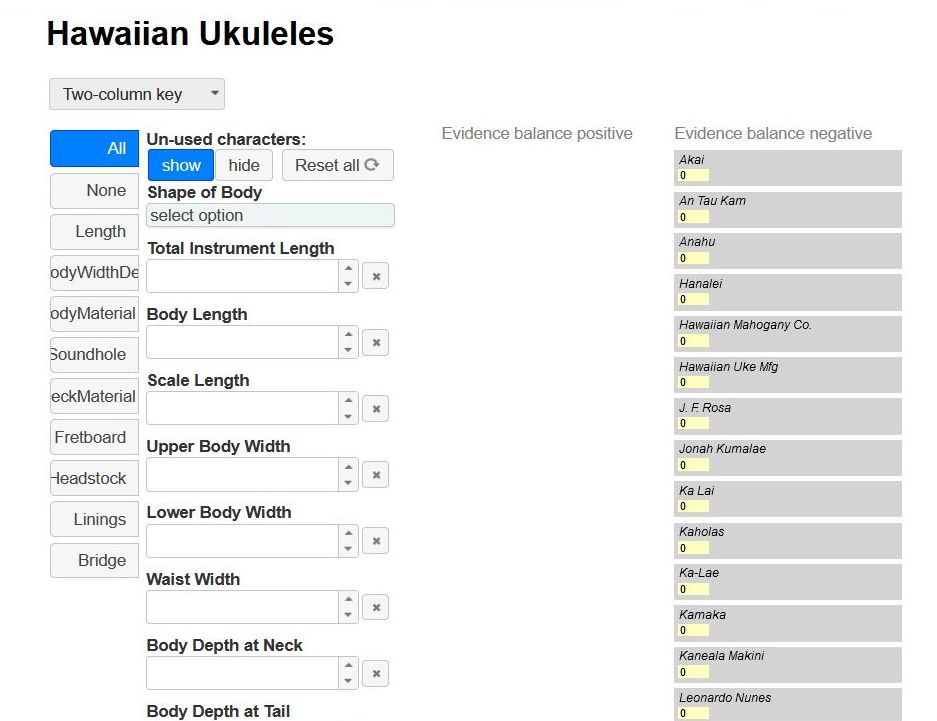
To use the program you have a choice of data manipulation methods. If you’re just curious about how the program works, begin by pressing the “UP” arrow on “Total Instrument Length”. As the numbers increase, different manufacturers appear and disappear as their data becomes more or less relevant. For a different presentation, go to the top-most box labeled “2-column key” and choose “circle-pack key”. If you want to see all the data for a single manufacturer, choose “Full Taxon Details”.
If you now want to check out one of your own ukuleles that might not have a label inside or a decal on the headstock, it’s time to make and enter measurements. On the left hand side of the screen are a list of physical characteristics of the ukuleles in the database. With ruler in one hand and ukulele in the other, make a measurement such as the total ukulele length in inches, and see which maker on the listing comes closest. Note that these measurements are for soprano sized ukuleles. Note also that those manufacturers which don’t make ukuleles fitting the measurement won’t appear in the central column. Now continue making other measurements and text choices until there is only one choice left. The likelihood that the remaining choice and your instrument are from the same maker is now very high.
The key can only be as accurate as the number of samples and measurements put into it. In a few cases, I have many of the same brand, but in most cases I have only 1 or 2 samples. If you have old Hawaiian ukuleles from the time period late 1940’s or earlier and are willing to share a little of your time making one or more data entry forms, we can all benefit. Those contributing can be listed as participants if they wish.
If you have a pre WWII Hawaiian ukulele and would like to contribute to the database, please click on the link below to download a data entry form. When finished, please send it by email to: ukulele at ukuleles dot com .
Data Entry Form for Hawaiian Ukulele Database
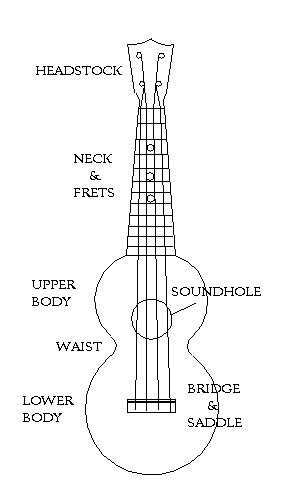 |
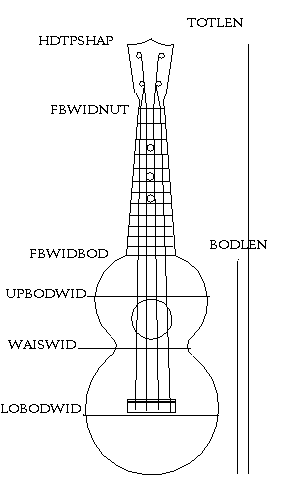 |
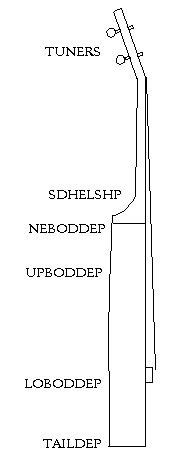 |
Here’s a listing of what brands I have measurements for and the number of samples (in parentheses) for each brand: An Tao Kam (3); Anahu (2); Hanalei (1); Hawaiian Mahogany Co. (4); Hawaiian Ukulele MFG. (1); J. F. Rosa (1); Jonah Kumalae (13); Kaneala Makini (2); Ka-Lae (2); Ka-Lai(1); Kaholas (1); Leonardo Nunes (1); Manual Nunes & Sons (3); Mossman (2); Mouna Loa (1); Paul Summers (3); Royal Hawaiian (2); Sam Chang (1); Singers Ukulele Mfg. (1); Ukulele Mfg. (2); Unis (1); Y’Ke’Ke (1).
I know that there is also a Kaai brand and there must be others as well. Further, it’s also known that several of the brands above were made by someone else: Paul Summers, Royal Hawaiian and Y’Ke’Ke for sure…, but who? Jonah Kumalae, the Nunes family and the Kamaka family made a tremendous number of instruments and may have been the maker for a number of stores and players such as Paul Summers.
Thank you for your interest and participation in this project. Anyone having additional questions, please contact me directly at the e-mail address on the home page of this website.
Building the Database
I’ve made about 40-45 different either numerical measurements or verbal observations on each ukulele. To some it’s a lot, to others too little. As I’ve mentioned, it’s a start. What follows now is a listing and description of the variable names along with a simple drawing of the instrument to help to illustrate the various measurements (above).Please note that I’ve changed the variable names listed below to make them more easily understandable.
There are two types of descriptors in the database: numeric and text. The numeric measurements are in inches. Most of these measurements are to 0.01 inches where possible. The text descriptors involve shape (somewhat subjective on my part) and type of materials used in construction.
Numeric Measurements
TotalLength – total length of the instrument
BodyLength – total length of the top of the body
ScaleLength – scale length or distance from nut to saddle; the scale length is indicative of the size of the instrument and is the actual playing length of the strings. For details of scale lengths and other general dimensions for different size ukuleles see Sounds and Strings
UpBodWidth – greatest width of the upper body
LoBodWidth – greatest width of the lower body
WaistWidth – width of the waist
NeckBodyDepth – body depth at neck
TailDepth – body depth at tail block
UpBodyDepth – body depth at mid upper body
LoBodyDepth – body depth at mid lower body
FBWidthAtNut – the width of the fretboard at the nut
FBWidthAtBody – the width of the fretboard at the body
SoundHoleDiam – the soundhole diameter
HdBotThick – thickness of bottom of the headstock
HdTopThick – thickness of top of the headstock
HdBotWidth – width at bottom of the headstock
HdTopWidth – width at top of the headstock
BridgeTotalHght – the bridge + saddle thickness. This measurement depends on the angle of the neck to the body and whether or not there is a fretboard on the neck.
BidgeThickness – the thickness of the bridge without the saddle
BridgeTotalWidth – total width of the bridge
BridgeTotalDepth – total depth of the bridge front to back
Text Descriptions
NeckWood – type of wood used in neck (Choices are: koa, mahogany, monkeypod, mango)
BodyWood – type of wood used in body (Choices are: koa, mahogany, monkeypod)
HeadstockShape – shape of the top of the headstock. (Choices are: Crown level – all three points are the same height;Crown center high – self explanatory; banjo – like body outline inverted and/or tilted) Akai ukuleles sometimes have an asymmetrical shape like a Dairy Queen hair-do or Cupie Doll. See pictures of Hawaiian ukuleles HERE and the database for a better understanding.
Tuners – type of tuners (Choices are: Wooden peg, Patent, White plastic)The 1920’s was a great time for ukulele tuners because manufacturers such as Grover could gear up and do an imaginative and professional job.
Nutcomp – composition of the nut. Choices are: Koa, Wood (undetermined type), White plastic
Nutshape – side profile of the nut (Choices are: square, 1/2 round)
FretMetal – composition of the frets (Choices are: brass, nickel silver)
Fretshape – side profile of the fret (Choices are: Vee, Tee, Straight)
BodyShape – general body shape (Choices are: Old Style Figure Eight, Guitar, Pineapple)
FrBkBraces – number of top (first number) and back (second number) braces (Choices are: one/one, two/one, three/one, two/two, four/two)
Lincomp – composition of lining (Choices are: white wood, mahogany, koa, rattan)
LinSlotStyle – style of slotting the linings (Choices are: Slots, No slots {smooth}, Stamped {to make indentations})
LinSlotDir – which way do the lining slots face? (Choices are: Facing toward sides, Facing away from sides, None)
BridgeOnePiece – are bridge and saddle one piece or separate? (Choices are: Yes, No)
KnotSlot – shape of the knot slots.(Choices are: Long slot, Slight slot, small round holes, square holes) Remarkably enough, this is an extremely diagnostic characteristic of different makers, because nearly every ukulele maker’s bridge is different.
 |
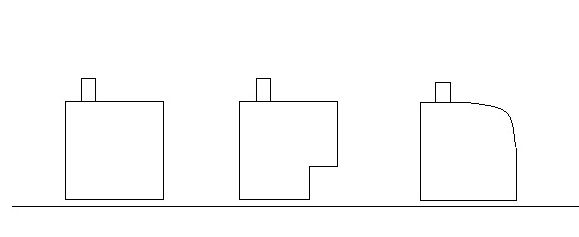 |
I enjoy writing these pages and hope that they are interesting and useful to the reader. I’ve stopped building at this time and still need to generate some income in order to continue to expand this website with more useful articles. If this page was helpful to you and you would like to make a $10.00 donation in order to have more pages like it, please use the donation button below. Thank you.